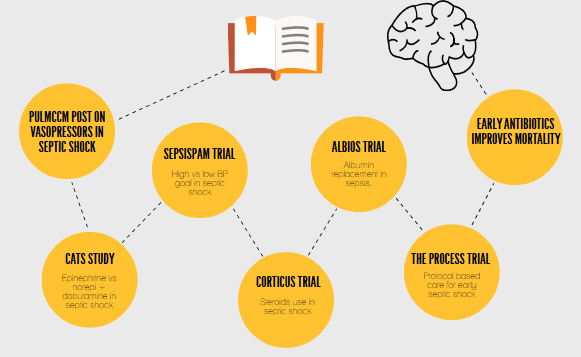
“You are aware that there are two main approaches to the management of septic shock in a patient such as Ms. Jones. One approach involves serial measurement of central venous pressure, central venous oxygen saturation (Scvo2), and hemoglobin, and following the early, goal-directed therapy (EGDT) protocol, in which specified targets are used for the initiation of inotropic agents or transfusion of red cells.1 For example, if the central venous pressure is less than 8 mm Hg, additional fluid resuscitation is administered; if the Scvo2 is less than 70%, the patient receives a transfusion of red cells until a hematocrit goal of at least 30% is reached, and if the Scvo2 remains less than 70%, inotropic support is initiated.
The second approach involves continuing intravenous administration of antibiotics and vasopressors, guided by clinical signs including blood pressure and urine output, without serial central venous pressure monitoring, serial Scvo2 monitoring, transfusion of red cells, or administration of inotropic agents. You are undecided about which of these approaches would maximize the chance of survival for your patient with septic shock.”
The foregoing excerpt from the article entitled Management of Septic Shock by Rebecca E. Berger, M.D., Emanuel Rivers, M.D., and Mitchell M. Levy, M.D. in the June 8 issue of the New England Journal of Medicine(N Engl J Med 2017; 376:2282-2285, DOI: 10.1056/NEJMclde1705277, http://bit.ly/2rrPLpK), describing two clinical approaches to the management of septic shock, imply the difficulty of managing a potentially fatal pathology progression. This difficulty stems from the fact that a detailed protocol must be executed perfectly and in a timely manner. Such execution, which must occur in a the complicated and confused context of an emergency department or inpatient care venue, can create cognitive overload and thereby put effective execution and patient safety at risk.
Wouldn’t it be helpful and potentially life-saving if there were “an app for that?” Now there can be an app, a.k.a. an information technology (IT) software application typically for use via a mobile digital device, for that; and it can be created and modified as needed by a healthcare provider subject matter expert (SME) with minimal cost and complexity (i.e. — with little or no need for IT staff or system support). A software solution compliant with the Cloud Healthcare Appliance Real-Time Solution as a Service (CHARTSaaS) reference architecture (RA) can enable healthcare provider SMEs to accomplish this, and the app thereby created can save a life.
A CHARTSaaS™ RA-compliant IT solution can enable SMEs to design, develop, deploy and operate apps that leverage installed EHR/EMR systems to implement automated cognitive support including the following capabilities (usable with minimal IT assistance by employing drag-and-drop, formatted text entry, table completion and other techniques not requiring computer coding capabilities):
- Analytics — Select from available list or create new artifact of Bayesian multi-variate analyses for similarity and predictive purposes;
- Automation — Select from available list [of CHARTSaaS-created artifacts] launch/terminate operation with/without edit of run-time conditions;
- Casefiles — Select from available list or create new artifact and edit/delete source database/dataset pathway/location and record subset definition [including location of and policies for use of publicly accessible evidence-based medical records a.k.a. charts that are the patient-identifiable responsibility of the CHARTSaaS Subscriber/user and/or the de-identified public records managed by such organizational custodians of CDC, CMS and WHO];
- Collaboration — Select from available list or create new artifact [including authorized collaborator users] and edit/delete social media to be incorporated (e.g. – Facebook, Twitter, LinkedIn);
- Events-Things — Select from available list or create new artifact and edit/delete source/device, parameter(s) to be managed, data thresholds/limits, time durations and/or dates/times of occurrence;
- Information — Select from available list or create new artifact and edit/delete source locations/pathways, extract/transform/load parameter values and destination locations [for typically narrative and/or unstructured data from any Internet-accessible source];
- Interoperability — Select from available list or create new connectivity and/or communication artifact [including legacy/installed EHR/EMR and other ancillary/departmental systems/applications] and edit/delete connection end points and transport parameter values, including data formatting and encryption;
- Mobility — Select from available list or create new artifact and edit/delete form factor [desk-top, laptop, tablet or phone (Android® or iOS® )], operating system and/or other parameters needed for automated code download and conversion for destination device;
- Modeling — Select from available list or create new artifact and edit/delete swim-lane flowchart description [implemented using Microsoft® Visio® or IBM® Bluworks Live® or any other BPMN-compliant process modeling tool, and to be convertible to run-time code with a one-click software button invoking Object Management Group (OMG)® Business Process Management Notation (BPMN)® ];
- Monitoring — Select from available list or create new artifact and edit/delete business activity monitoring tool name and location and configuration data values a.k.a. key performance indicators (KPIs) [functionality typical of COTS business activity monitoring (BAM) solution];
- Optimization — Select from available list or create new artifact and edit/delete version management data and comparative effectiveness data; and
- Decision-making — Select from available list or create new artifact and edit/delete Boolean decision management parameter data in decision table [implemented using Microsoft® Excel® and to be convertible to run-time code with a one-click software button invoking Object Management Group (OMG)® Decision Management Notation (DMN)® ] and/or If…Then…Else format and locations of subject data for evaluation/testing.
Please validate to your own satisfaction that a CHARTSaaS-built app can facilitate improved effectiveness of septic shock management by reading the white paper at http://bit.ly/2r1OtoR and then by reviewing the details of CHARTSaaS™ and the CHARTSaaS RA™ in these presentations:
Healthcare providers will benefit significantly from appreciating and then applying a CHARTSaaS RA-compliant IT solution. To do so will mitigate medical mistakes (currently the third leading cause of patient deaths. per Makaray and Daniel (re http://bit.ly/1rtW6Sa); thereby minimizing patient adverse events and optimizing clinical case outcomes while maximizing the cost-effectiveness of care and treatment, and also accelerating the accrual and facilitating the application of medical knowledge.